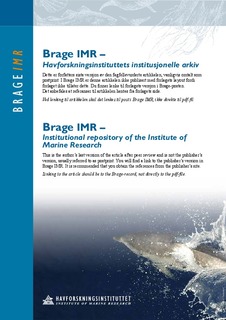| dc.contributor.author | Nilsson, Jonatan | |
| dc.contributor.author | Torgersen, Thomas | |
| dc.date.accessioned | 2010-11-25T14:36:02Z | |
| dc.date.available | 2010-11-25T14:36:02Z | |
| dc.date.issued | 2010-08-15 | |
| dc.identifier.issn | 0044-8486 | |
| dc.identifier.uri | http://hdl.handle.net/11250/108571 | |
| dc.description | Journal homepage: http://www.elsevier.com/wps/find/journaldescription.cws_home/503302/description#description | en_US |
| dc.description.abstract | A bite–and–pull demand–feeding system was introduced to groups of cultured cod (Gadus morhua). For half of the groups trigger actuations were rewarded with food, while actuations
were unrewarded in the other groups. Initially, cod responded with frequent triggering, irrespective of whether triggering was rewarded with food or not. The high initial curiosity–driven triggering rate declined rapidly, and was almost perfectly described by an exponential decay model with a decay rate of 7% min-1. After 3 hours, the triggering frequency of the rewarded fish diverged from that of unrewarded fish, and it remained higher throughout the 9
days of the experiment. The initial curiosity–driven triggering allowed the cod to establish the relationship between action and reward in a short time. It is inferred that the time trajectory of action frequency of rewarded fish is the result of several factors and that operant learning can only be verified by comparing action frequencies of rewarded and unrewarded fish, and not
by the temporal development in action frequency of rewarded fish alone. | en_US |
| dc.language.iso | eng | en_US |
| dc.publisher | Elsevier | en_US |
| dc.subject | atlantic cod | en_US |
| dc.subject | atlantisk torsk | en_US |
| dc.subject | behavioral studies | en_US |
| dc.subject | atferdsstudier | en_US |
| dc.title | Exploration and learning of demand-feeding in Atlantic cod (Gadus morhua) | en_US |
| dc.type | Journal article | en_US |
| dc.type | Peer reviewed | en_US |
| dc.subject.nsi | VDP::Agriculture and fishery disciplines: 900::Fisheries science: 920::Aquaculture: 922 | en_US |
| dc.source.pagenumber | 384-387 | en_US |
| dc.source.volume | 306 | |
| dc.source.journal | Aquaculture | |
| dc.source.issue | 1-4 | |
| dc.identifier.doi | http://dx.doi.org/10.1016/j.aquaculture.2010.05.029 | |
